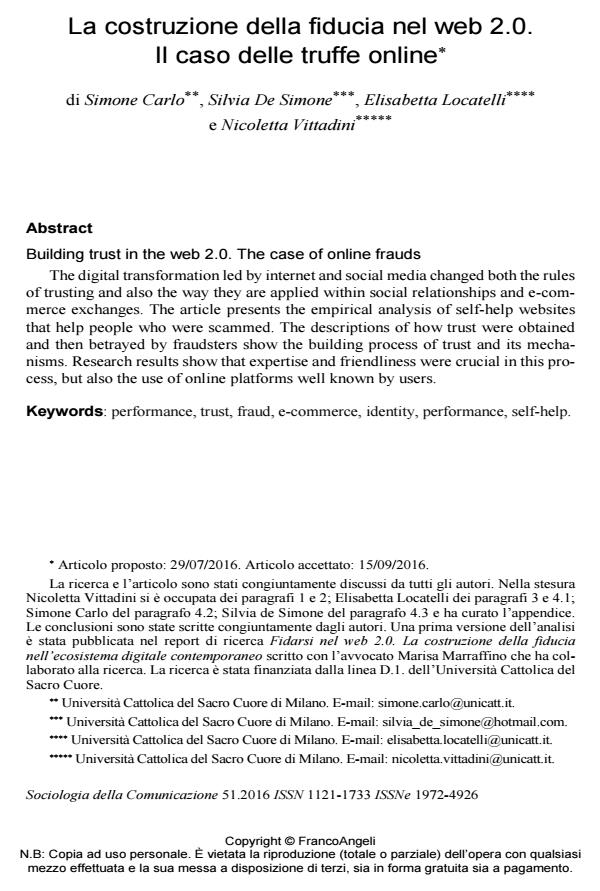La costruzione della fiducia nel web 2.0. Il caso delle truffe online
Titolo Rivista SOCIOLOGIA DELLA COMUNICAZIONE
Autori/Curatori Simone Carlo, Silvia De Simone, Elisabetta Locatelli, Nicoletta Vittadini
Anno di pubblicazione 2016 Fascicolo 2016/51
Lingua Italiano Numero pagine 19 P. 64-82 Dimensione file 224 KB
DOI 10.3280/SC2016-051005
Il DOI è il codice a barre della proprietà intellettuale: per saperne di più
clicca qui
Qui sotto puoi vedere in anteprima la prima pagina di questo articolo.
Se questo articolo ti interessa, lo puoi acquistare (e scaricare in formato pdf) seguendo le facili indicazioni per acquistare il download credit. Acquista Download Credits per scaricare questo Articolo in formato PDF

FrancoAngeli è membro della Publishers International Linking Association, Inc (PILA)associazione indipendente e non profit per facilitare (attraverso i servizi tecnologici implementati da CrossRef.org) l’accesso degli studiosi ai contenuti digitali nelle pubblicazioni professionali e scientifiche
La digitalizzazione delle relazioni sociali operata dai social media e dalla rete, ha parzialmente rinnovato le regole attraverso cui si attribuisce fiducia a un interlocutore e il modo in cui queste vengono applicate sia nelle relazioni sociali sia nello scambio di beni. Nell’articolo si presenta l’analisi empirica di un luogo privilegiato di osservazione: i gruppi di auto aiuto di soggetti che hanno subito truffe online. La descrizione del momento in cui la fiducia viene carpita o tradita, infatti, consente di mettere in luce meccanismi attraverso cui è stata costruita e accordata. I risultati mostrano come siano cruciali competenza e benevolenza, ma anche l’uso di specifiche piattaforme che avvicinano in modo familiare gli interlocutori.
Parole chiave:Ffiducia, truffe, performance, identità, auto-aiuto
- Artz D., Gil Y. (2007), A survey of trust in computer science and the Semantic Web, «Web Semantics: Science, Services and Agents on the World Wide Web», Vol. 5, Issue 2, pp. 58-71.
- Blau P.M. (1964), Exchange and power in social life, John Wiley & Sons, New York.
- Clusit (2015), Rapporto Clusit 2016 sulla sicurezza ICT in Italia, https://clusit.it/rapportoclusit/.
- Coleman J.S. (1990), Foundations of social theory, Harvard University Press, Cambridge, MA.
- Das R., Pavlìčová T. (2013), Is there an author behind this text? A literary aesthetic driven approach to interactive media, in «New Media & Society», Vol. 16, n. 3, pp. 381-397. DOI: 10.1177/1461444813481296
- Garfinkel H. (1967), Studies in ethnomethodology, Prentice-Hall, Englewood Cliffs, NJ.
- Giddens A. (1990), The consequences of modernity, Stanford University Press, Stanford.
- Gili G., Colombo F. (2012), Comunicazione, cultura, società, La Scuola, Brescia.
- Glaser B.G., Strauss A.L. (1967), The Discovery of Grounded Theory; Strategies for Qualitative Research, Aldine Pub. Co., Chicago; trad. it. (2009), La scoperta della grounded theory: strategie per la ricerca qualitativa, Armando, Roma.
- Goffman E. (1959), The presentation of self in everyday life, Random House, New York; trad. it. (1969), La vita quotidiana come rappresentazione, il Mulino, Bologna.
- Grabner-Kräuter S. (2009), Web 2.0 social networks: The Role of Trust, in «Journal of Business Ethics», Vol. 90, Supplement 4, pp. 505-522.
- Grandison T., Sloman M. (2000), A survey of trust in internet applications, in «IEEE Commun. Surv. Tutorials», Vol. 4, n. 4, pp. 2-16.
- Holzner B., Robertson R. (1980), Identity and authority. A problem analysis of processes of identification and authorization, in R. Robertson, B. Holzner (eds.), Identity and authority, Blackwell, Oxford, pp. 1-39.
- Luhmann N. (1979), Trust and power, John Wiley & Sons, New York.
- McKnight D.M., Chervany M.L. (1996), The meanings of trust, Technical Report 94-04, Carlson School of Management, University of Minnesota.
- Mcpherson M., Lovin L.S., Cook J.M. (2001), Birds of a feather: Homophily in social networks, in «Ann. Rev. Sociol.», Vol. 27, n. 1, pp. 415-444.
- Mui L.M., Mohtashemi A., Halberstadt A. (2002), Computational model of trust and reputation for E-businesses. Proceedings of the 35th International Conference on System Science, pp. 280-287.
- Netcomm (2015), Netcomm e-commerce Forum, URL: http://goo.gl/T6Qu6hOfcom (2010), Online trust and privacy: People’s attitude and behaviour, disponibile onlinehttp://stakeholders.ofcom.org.uk/binaries/research/media-literacy/trust-privacy.pdf.
- Parsons T. (1969), Politics and social structure, Macmillan-The Free Press, New York; trad. it. (1975), Sistema politico e struttura sociale, Giuffrè, Milano.
- Pavlìčová T. (2013), Trust in the author: Identity, expertise and reputation, CM: Communication Management Quarterly: Časopis za upravljanje komuniciranjem, 26, pp. 33-50.
- Potts H.W.W. (2005), Online support groups: an overlooked resource for patients, in «He@lth Information on the Internet», Vol. 44, n. 1, pp. 6-8.
- Rotter J.B. (1971), Generalized expectancies for interpersonal trust, in «American psychologist», XXVI, pp. 443-452.
- Rousseau D.M., Sim B., Bitkin R., Burt S., Colin C. (1998), Not So Different After All: A Cross- Discipline View of Trust, in «Academy of Management Review», Vol. 23, n. 3, pp. 393-404. DOI: 10.5465/AMR.1998.926617
- Sherchan W., Nepal S., Paris C. (2013), A Survey of trust in social networks, in «ACM Comput. Surv.», Vol. 45, n. 4, Article 47 (August), 33 pages.
- Simmel G. (1908), Soziologie. Untersuchungen über die Formen der Vergesellschaftung, Leipzig; trad. it. (1989), Sociologia, Edizioni di Comunità, Milano.
- VanderZee K., Vosand M., Luijters K. (2009), Social Identity Patterns and Trust in Demographically Diverse Work Teams’, «SocialScience Information», Vol. 48, n. 2, pp. 175-198.
Simone Carlo, Silvia De Simone, Elisabetta Locatelli, Nicoletta Vittadini, La costruzione della fiducia nel web 2.0. Il caso delle truffe online in "SOCIOLOGIA DELLA COMUNICAZIONE " 51/2016, pp 64-82, DOI: 10.3280/SC2016-051005